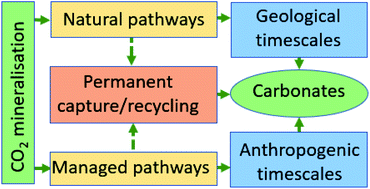Managed pathways for CO2 mineralisation: analogy with nature and potential contribution to CCUS-led reduction targets
Abstract
The managed mineralisation of CO2 on mineral substrates has significant potential to mitigate CO2 emissions to atmosphere, using processes that are analogous to the formation of limestone in nature. High-temperatures and pressures or ambient conditions can be applied in processes that compare with the natural chemical, hydrothermal or biological formation of limestone. In the UK, recent policy developments recognise the potential of carbon utilisation and a reduction target of 40 Mt by 2030 has been set. In the present work, the analogies between natural and managed carbonate-production are briefly reviewed and the potential gains for mineralisation technology employing flue-gas as a direct source of CO2 are presented. With reference to selected UK solid waste arisings, our high-level analysis indicates mineralisation is capable of permanently sequestrating 1.2 Mt per year of CO2 in carbonated construction products. At a European level, nearly 7.8 Mt of CO2 can be managed in the same way. If indicative indirect CO2 savings are also considered, maximum total CO2 reductions of up to 3 and 30 Mt per year are possible in the UK and Europe, respectively. In respect of the UK’s CCUS-led CO2 reductions for the 8 years to 2030, our high-level assessment suggests that up to 24 Mt, representing 60% of the ‘target’, may be met by the mineralisation of selected industrial process residues.

- This article is part of the themed collection: Carbon dioxide utilisation


 Please wait while we load your content...
Please wait while we load your content...